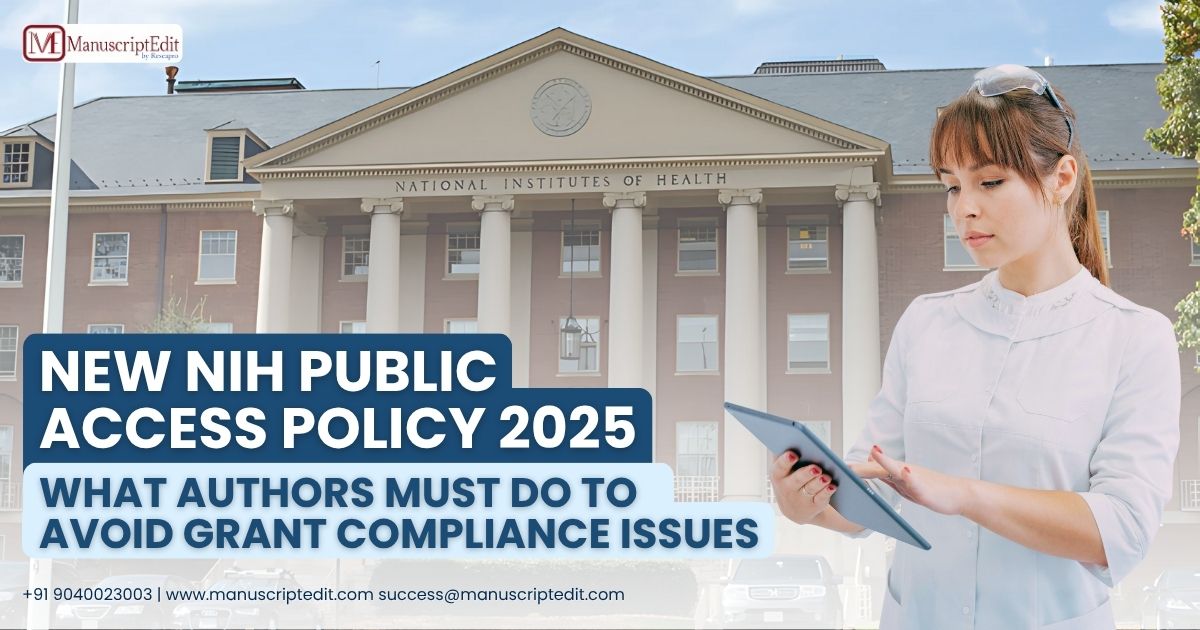
Why Journal Selection Now Matters More Than Ever
In 2025, the NIH introduced a game-changing open access policy that eliminates the traditional 12-month embargo. Now, if you’re funded by an NIH grant, your research must be made freely available immediately upon publication. This shift isn’t just a U.S. issue—it affects global researchers in India, the UK, and across the EU who collaborate on NIH-funded projects. Choosing the wrong journal could mean non-compliance, delayed publications, or funding penalties. In this evolving landscape, understanding NIH open access policy and selecting the right journal isn’t optional—it’s critical for your career, funding, and global research visibility.

Visual summary of the 2025 NIH zero-embargo policy requiring all funded research to be openly accessible upon publication. Based on NIH Notice NOT-OD-23-091.

In 2025, the NIH embargo policy underwent a significant shift. Under the new guidelines effective July 1, 2025, all NIH-funded research must be made publicly available immediately upon publication — eliminating the previous 12-month embargo window. This means authors can no longer delay open access deposit into PubMed Central or similar repositories.

For researchers, especially in the UK, India, and Europe, this policy change poses new challenges. Many high-impact journals still enforce embargo periods, making them non-compliant under the new NIH rules. If a manuscript is submitted to such a journal, it may jeopardise funding eligibility or result in administrative delays.

To stay compliant, authors must now prioritise zero embargo journals or secure publisher permissions allowing immediate public access. Understanding these nuances is vital — not only to meet NIH requirements, but also to ensure international collaborations aren’t derailed by policy mismatches.
NIH Compliance Shift 2025: Before vs After – What Authors Must Know
| Aspect | Before 2025 | After July 1, 2025 | Impact | Action Required |
| Embargo Period | Allowed 12-month delay before open access | No embargo allowed — immediate access | Journals with embargoes now non-compliant with NIH rules | Submit only to zero-embargo journals or obtain explicit publisher permission for OA |
| Access Platform | PubMed Central after embargo | PubMed Central upon publication | Earlier deposit now mandatory | Upload final accepted manuscript immediately after publication |
| Effect on Non-U.S. Authors | Less restrictive | Same rule applies globally | UK, EU, and Indian researchers collaborating with NIH grants must follow the same policy | Check that your target journal complies even if it’s outside the U.S. |
| Common Risk | Policy confusion manageable | High risk of funding delays or rejection | Choosing an embargoed journal could cause NIH to withhold funding or delay approvals | Use tools like NIH Compliance Checklist or consult experts before submitting |
| Funding Eligibility | Not impacted by journal selection | Directly linked to compliance | Non-compliance can disqualify otherwise strong projects | Rely on journal selection tools like ManuscriptEdit’s NIH Journal Finder |
Common Mistakes Authors Can Still Make

As the 2025 NIH policy takes full effect, many authors may still fall into traps that risk non-compliance. One common mistake will be submitting to high-impact journals like Nature, The Lancet, or Cell, which often maintain embargo policies that conflict with the new zero-embargo rule.
Others may overlook fine print in hybrid journals, assuming that any open access option is automatically NIH-compliant — which it may not be unless immediate repository deposit is permitted.
Researchers in India and Europe might also choose local journals that lack clear NIH-compatible open access policies or repository agreements.
Without checking embargo terms or using verified NIH-compliant journal lists, authors may unintentionally delay public access — risking grant delays, publication retraction, or future funding penalties.
Pro Tip: Always cross-check embargo terms before submission — don’t assume publisher “OA” means “NIH-safe.”
The 6-Point Checklist Before Submitting Your Paper
Before you hit “submit,” here’s a 6-point journal selection checklist to ensure your paper aligns with the NIH’s 2025 zero-embargo mandate — especially if you’re publishing through platforms like Springer Nature or Taylor & Francis, which many India-based researchers commonly choose.

1. Confirm NIH-Compliance:
Does the journal permit immediate open access (zero embargo) deposit in PubMed Central?
2. Verify Licensing Terms:
Ensure the journal supports a CC BY or equivalent license that allows public redistribution.
3. Check Hybrid Journal Fine Print:
If hybrid, does the open access option meet NIH standards — or still delay repository access?
4. Review Repository Permissions:
Is your accepted manuscript allowed to be deposited immediately?
5. Avoid Journal-Level Embargoes:
Journals with default embargoes (e.g., 6 or 12 months) are not NIH-compliant.
6. Use a Verified Journal Finder:
Use trusted NIH-compliant journal selection tools or consult experts like ManuscriptEdit.
Need help? Upload your manuscript and get a free NIH compliance report.
ManuscriptEdit Can Help — Wherever You’re Publishing?
Struggling to find NIH-compliant journals or decode publisher embargo terms? Manuscriptedit’s experts provide journal matching services, copyright guidance, and repository compliance checks—tailored for researchers funded by NIH and other global agencies.
Whether you’re based in the U.S., UK, or India, our time zone-aligned support ensures your queries are addressed quickly. We monitor shifting publisher policies across Springer, Elsevier, Taylor & Francis, and more—so you don’t have to.
Upload your manuscript for a free NIH-compliance check
(Your research deserves zero delays. We’ll help you get it right, the first time.). Click below to avail our flagship service.
NIH compliant journal selection service to avoid delay’s or rejections
Download Your Free Checklist: Stay Compliant & Confident
Get instant access to our NIH compliance checklist—a downloadable, researcher-friendly tool that guides you through every requirement step by step.
Updated for 2025 NIH journal policies
Useful for authors publishing from the U.S., UK, EU, and India
Print-ready + ideal for grant documentation

[Download Now — No sign-up required]
Conclusion + FAQ: Your 2025 NIH Journal Mandate Guide
The 2025 NIH policy changes are reshaping how and where authors publish. Staying ahead requires clarity—not guesswork. Use this blog and checklist as your foundation and consult our [FAQ page] for answers to common queries on embargo rules, PubMed Central deposits, and zero-delay journal selection.
NIH mandates may change. Your compliance shouldn’t.



